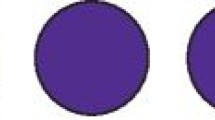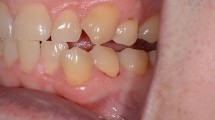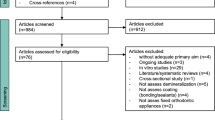Abstract
Data sources
Medline, Embase, the Cochrane Central database as well as the Cochrane Oral Health Group's Trials Register and the National Research Register. In addition relevant journals were hand searched from 2000 to 2010 (Lasers in Medical Sciences, Lasers in Surgery and Medicine, Photomedicine and Laser Surgery, Photodiagnosis and Photodynamic Therapy, Journal of Oral Rehabilitation, Journal of Periodontology, Journal of Clinical Periodontology, Journal of Endodontics, Clinical Oral Investigations, Journal of Dental Research, Journal of Oral Laser Applications, Journal of Periodontal Research and Periodontology 2000) together with the reference lists of relevant trials.
Study selection
Randomised controlled trials (RCT) that included patients with two or more hypersensitive teeth confirmed by evaporative stimulus or tactile hypersensitivity assessment, comparing laser therapy versus other topical desensitising agents, such as fluoride varnish, dentine bonding agents etc, that were published in English.
Data extraction and synthesis
Studies were assessed for quality by two reviewers independently and data were extracted using a standardised form. Because of heterogeneity of the studies meta-analysis was not performed, so a qualitative synthesis is presented.
Results
Eight trials (234 participants) met the inclusion criteria. Half of the included studies compared GaALAS laser with topical desensitising agents, but the findings were conflicting. The remaining studies involved Nd:YAG laser, Er:YAG laser and CO2 laser, and all showed that the three types of lasers were superior to topical desensitising agents, but the superiority was slight.
Conclusions
The review suggests that laser therapy has a slight clinical advantage over topical medicaments in the treatment of dentine hypersensitivity. However more large sample-sized, long-term, high-quality randomised controlled clinical trials are needed before definitive conclusions can be made.
Similar content being viewed by others
Commentary
Dentine hypersensitivity, a short, sharp pain arising from exposed dentine in response to stimuli that cannot be ascribed to any other form of dental defect or pathology, is a common presentation in the dental office. General dentists reported to frequently use on average three products or techniques and to have tried eight different products or techniques for the treatment or management of this condition. The plethora of products and techniques may indicate that no single treatment is effective and, currently, there is no evidence demonstrating the superiority of any one desensitising agent. The reviewed study assessed the effectiveness and safety of lasers in the treatment of dentine hypersensitivity through a systematic review.
Lasers have been used for this purpose since the mid-1980s and their effectiveness has been tested in just a few randomised clinical trials. This systematic review identified eight randomised clinical trials with moderate- to high-risk of bias and concluded that lasers are slightly superior to other topical desensitising treatments. In particular, Nd:YAG laser, Er:YAG laser and CO2 laser therapies were superior to topical desensitising agents (eg fluoride varnish), while results for GaALAS laser were inconsistent.
The systematic review compared laser treatments to an active control group - topical desensitising agents. The reason for choosing this comparison group instead of a placebo is not clear. The testing of effectiveness of dentine hypersensitivity treatments has been challenged by the difficulty in proving a result superior to the placebo effect. In contrast with the current systematic review, another systematic review on this topic, including only placebo controlled trials, identified three randomised controlled trials which showed that lasers were not superior to placebo.
A descriptive sysnthesis of the trials is provided in the systematic review; meta-analysis was not considered appropriate by the authors given the heterogeneity of the included studies. A random-effects meta-analysis could have been performed to calculate standardised mean differences which would take into account the different scales used in the trials. In addition, statistical heterogeneity could have been reported.
Based on the data from the included studies, a meta-analysis would yield the following results: Er:YAG laser (n=2 trials) and CO2 (n=1 trial) were statistically significantly superior to other topical desensitising agents, while GaALAS laser (n=4 trials) and Nd:YAG laser (n=2 trials) were not (Figure 1). The clinical heterogeneity and the quality of the trials and the high level of statistical heterogeneity (I2> 90% for all comparisons, except Nd:YAG laser) would prevent us from relying on those summary estimates.
Safety of the laser treatments was one of the objectives of the systematic review. Five trials reported on adverse effects, and no detrimental pulpal effects, allergic reactions or clinically detectable complications during the follow-up periods were observed. The authors concluded that, based on the limited evidence, laser treatment for dentine hypersensitivity was safe. However, the sample sizes of the studies do not allow for such conclusions and rare side effects of the laser treatment would not have been identified. Large simple randomised clinical trials would be necessary to assess the safety of laser therapy.
Other limitations of this systematic review included the restriction of the publication language to English (as noted by the authors) and the exclusion of studies with 'confusing data or probable errors'. It is not clear what the criteria were for considering including? a study with confusing data or probable errors, or whether the authors of those studies were contacted to clarify the data. Twenty trials that did not meet the inclusion criteria were excluded, but the exact number of trials excluded due to non-English language and/or confusing data was not reported. These limitations may have introduced selection bias, which may impact upon the conclusions of the review.
In conclusion, there is no strong evidence that laser therapy decreases dentine hypersensitivity. Given the cost, questionable efficacy and unknown safety of this treatment, and the availability of other treatments, dentists should be cautious when using laser therapy for treatment of dentine hypersensitivity patients. The evidence base for recommending this treatment is weak and further clinical trials with adequate sample size and design are necessary to guide clinical practice.
References
Cunha-Cruz J, Wataha JC, Zhou L . Treating dentin hypersensitivity: therapeutic choices made by dentists of the northwest PRECEDENT network. J Am Dent Assoc 2010; 141: 1097–1105.
He S, Wang Y, Li X, Hu D . Effectiveness of laser therapy and topical desensitising agents in treating dentine hypersensitivity: a systematic review. J Oral Rehabil. 2011; 38: 348–358.
Holland GR, Narhi MN, Addy M, Gangarosa L, Orchardson R . Guidelines for the design and conduct of clinical trials on dentine hypersensitivity. J Clin Periodontol. 1997; 24: 808–813.
Sgolastra F, Petrucci A, Gatto R, Monaco A . Effectiveness of laser in dentinal hypersensitivity treatment: a systematic review. J Endod. 2011; 37: 297–303
Author information
Authors and Affiliations
Additional information
Address for correspondence: Dr. Xue Li, Department of Preventive Dentistry, West China College of Stomatology, Sichuan University, No. 14, Section 3, Road Renminnan, Wuhou District, Chengdu, China. E-mail: gardonlixue@sina.com
He S, Wang Y, Li X, Hu D. Effectiveness of laser therapy and topical desensitising agents in treating dentine hypersensitivity: a systematic review. J Oral Rehabil 2011; 38: 348–358.
Rights and permissions
About this article
Cite this article
Cunha-Cruz, J. Laser therapy for dentine hypersensitivity. Evid Based Dent 12, 74–75 (2011). https://doi.org/10.1038/sj.ebd.6400807
Published:
Issue Date:
DOI: https://doi.org/10.1038/sj.ebd.6400807
This article is cited by
-
Network meta-analysis of the desensitizing effects of lasers in patients with dentine hypersensitivity
Clinical Oral Investigations (2019)
-
Effectiveness on oral pain of 808-nm diode laser used prior to composite restoration for symptomatic non-carious cervical lesions unresponsive to desensitizing agents
Lasers in Medical Science (2017)
-
The role of fluoride in the preventive management of dentin hypersensitivity and root caries
Clinical Oral Investigations (2013)




